Famous Rings in History: Iconic Symbolism Explored
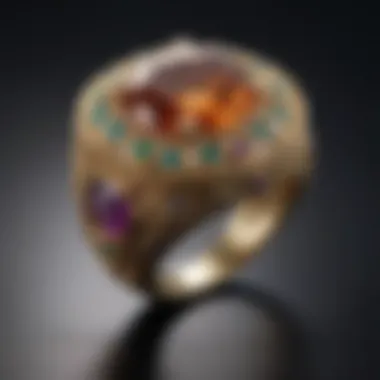
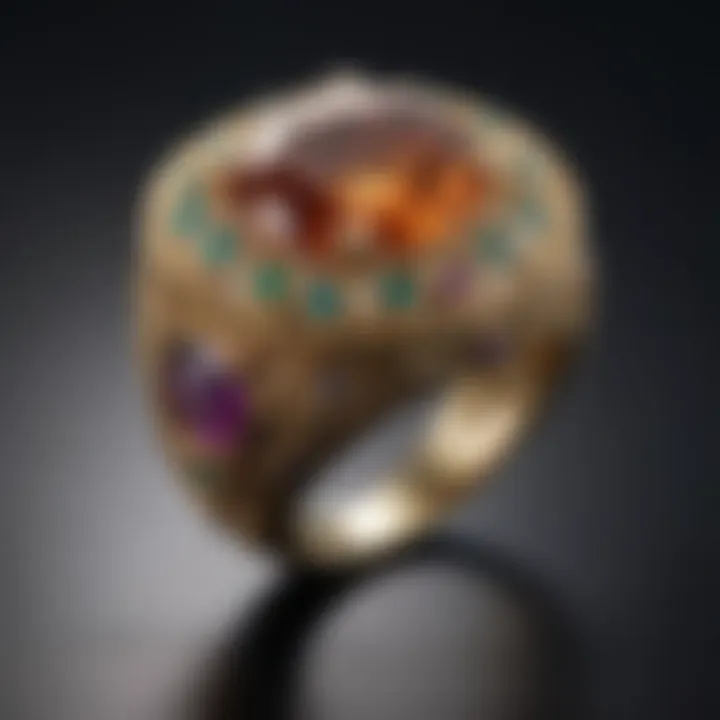
Intro
Rings have held significant value throughout history, serving as symbols of power, love, and commitment. Various cultures have embraced rings as forms of expression, often embedding profound meanings into their designs. This article aims to examine not only the visual aspects but also the cultural narratives behind famous rings. By exploring the craftsmanship and symbolism of these pieces, we delve into the psychological and historical depths they embody. Understanding these elements allows collectors and historians to appreciate rings beyond their mere aesthetic appeal.
Gemstone Overview
Definition and Characteristics
Gemstones are naturally occurring materials prized for their beauty, durability, and rarity. They are defined by their form, color, transparency, and crystalline structure. Each gemstone possesses specific properties depending on its chemical composition and formation. Understanding these characteristics is crucial when evaluating a ring's historical and cultural significance.
Classification of Gemstones
Gemstones are typically classified into two main categories: precious and semi-precious. The precious gemstones include diamonds, rubies, sapphires, and emeralds, known for their desirability and value. Semi-precious stones encompass a broader range such as amethyst, topaz, and garnets, still sought after but generally less valuable.
- Precious Gemstones:
- Semi-Precious Gemstones:
- Diamonds
- Rubies
- Sapphires
- Emeralds
- Amethyst
- Topaz
- Garnet
Understanding the classification provides context to the rings' symbolic meanings in historical events and personal relationships.
Properties of Gemstones
Physical Properties
The physical properties of gemstones play a crucial role in their suitability for jewelry-making. These include hardness, luster, and refractive index. For example, diamonds are known for their remarkable hardness, making them ideal for engagement rings, while sapphires exhibit a brilliant luster that enhances their appeal.
Chemical Properties
From a chemical standpoint, gemstones vary greatly, which influences their color and durability. For instance, the vibrant reds of rubies stem from chromium in their structure. Meanwhile, the deep blue of sapphires results from the presence of iron and titanium. Understanding these properties aids in appreciating the craftsmanship that goes into creating a ring.
"Rings are not just ornaments; they are narratives etched in metal and stone, telling stories of their wearers through generations."
As we navigate through famous rings in history, we will encounter their craftsmanship, symbolism, and the cultural contexts that shaped them. This exploration will unveil the layers of meaning behind these admired artifacts and offer insights into why they resonate with audiences today.
Preface to Rings in History
Rings have been part of human culture for thousands of years. Their history is not just about adornment; they carry meanings that transcend mere decoration. Rings symbolize power, love, fidelity, and authority across various cultures. Each type of ring tells a story about the society that produced it. Understanding the significance of rings helps to appreciate their role in shaping individual identities and cultural narratives.
Throughout historical periods, rings have been prevalent in personal and political relationships. They often served as status symbols or tokens of loyalty. Many historical events are intertwined with these pieces of jewelry. Thus, the exploration of rings provides insights not just into craftsmanship but also into the evolution of social customs and beliefs.
In this article, we will examine different types of iconic rings and their meanings. We will explore their craftsmanship and the materials used. This will offer a comprehensive understanding of their impact throughout history.
The Role of Rings in Society
Rings have served various functions in society. They can signify social status, commitments like marriage, or milestones in life. In many societies, a ring is a token of engagement and symbolizes the union of two people. It speaks volumes about values of loyalty and promise.
Moreover, rings often hold religious significance. When exchanged during ceremonies, they can carry blessings and intentions. They symbolize eternal love in many cultures. The cyclical nature of a ring reflects an infinite bond.
In contexts beyond personal relationships, rings have also played role in governance and authority. For instance, signet rings were historically used to seal documents and legitimize authority. An official might wear one to signify their power and responsibility, as seen in royal and noble families.
Symbolism and Significance
The complexity of ring symbolism is vast. Each design and engraving can mean different things depending on the cultural context. For example, a stone set in a ring may represent specific virtues or attributes. The colors and types of gemstones also bear meaning. A diamond is often associated with strength and permanence, while sapphires may signify wisdom and royalty.
"A ring's value goes beyond the material. It embodies emotion, history, and belief."
In summary, rings are more than simple adornments. They have layered meanings that reflect societal values. Their history is deeply intertwined with human connections and societal structures. As we continue exploring this fascinating subject, we will uncover how rings have shaped attitudes and traditions across time and space.
Ancient Rings: A Look Back
The examination of ancient rings serves as a portal into the historical contexts of diverse cultures. These rings, often not mere adornments, held significant roles in social status, spirituality, and even politics. The craftsmanship of these rings reflects the techniques and materials available in those eras. This section vividly illustrates how these artifacts were not just accessories but significant symbols that provided insight into the people who wore them.
Egyptian Signet Rings
Egyptian signet rings are among the most fascinating artifacts from ancient times. Historically, they were not just decorative pieces but practical tools used for sealing documents. Made typically from materials like gold, silver, or stone, these rings often featured unique symbols or hieroglyphs that identified the owner. It was believed that the act of pressing a signet into ink was akin to casting a spell, linking the ring to the sacred and the official.
Key elements of Egyptian signet rings:
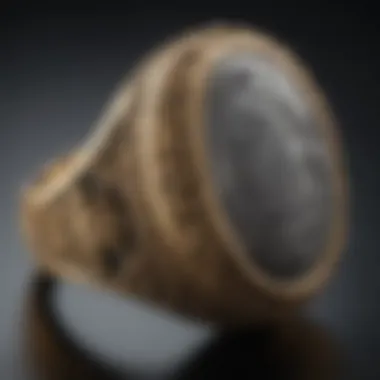
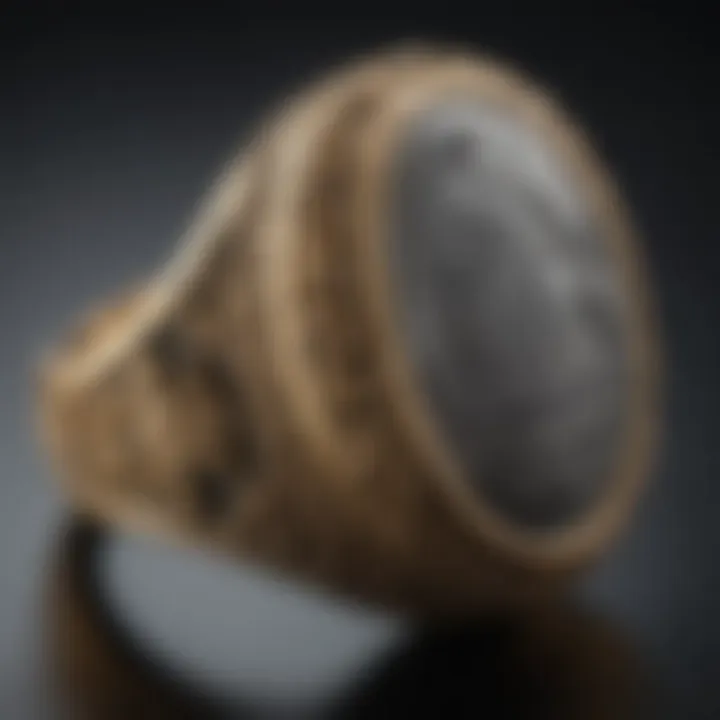
- Symbol of Authority: Worn by nobles and pharaohs, signet rings represented power.
- Craftsmanship: The intricate designs showcased the skills of Egyptian artisans. The use of lapis lazuli and other semi-precious stones added richness to the rings.
- Spiritual Significance: Many rings held symbols of deities, connecting the wearer to the divine.
Roman Wedding Rings
Roman wedding rings marked a pivotal moment in the lives of couples. Typically made of iron, bronze, or later, gold, these rings symbolized a man's ownership over his wife. However, as time progressed, they evolved into symbols of love and fidelity. Unlike modern traditions where the bride often wears a diamond or gem, Romans sometimes adorned their rings with simple engraving or a small gem.
Understanding Roman wedding rings involves:
- Cultural Shift: Initially practical, these rings gained romantic meaning over time.
- Material Varieties: The move from iron to precious metals illustrated wealth and status.
- Design Elements: Simple, yet often inscribed, these rings reflected the personal stories of trusting couples.
Greek Gemstone Rings
The Greeks placed a premium on gemstones, believing them to hold specific energies and powers. Greek gemstone rings often showcased intricate designs, combining artistry with the allure of natural crystals. These rings were not only fashion statements but also amulets meant to protect or bring luck to the wearer.
Key features of Greek gemstone rings include:
- Selection of Gemstones: Popular choices included amethyst, onyx, and garnet, each thought to possess unique properties.
- Artistic Flourish: Many featured mythological themes, fusing cultural storytelling with personal expression.
- Cultural Significance: Greek rings symbolized status and were often passed down as family heirlooms, integrating both personal and historical narratives.
"Rings of antiquity often echo the beliefs and values of their time. They are more than simple adornments; they represent complex histories and human connection."
The exploration of these ancient rings reveals diverse cultural stories. Each design and material selection embodies the values and traditions of ancient societies, showcasing their enduring legacy through time. Understanding these aspects enriches our appreciation of rings beyond mere aesthetics.
Medieval and Renaissance Rings
The period known as the Medieval and Renaissance eras represents a fascinating chapter in the history of rings. During this time, rings served not only as decorative items but also as powerful symbols of authority, faith, and unity. These rings often embodied intricate craftsmanship, as artisans combined various techniques and materials to convey significant meanings and societal values.
In addition to their aesthetic appeal, medieval and Renaissance rings often played important roles in the political and religious spheres. They were used as tokens of power and status, marking alliances, marriages, and lineage. Moreover, the evolution of craftsmanship during this period reflects wider cultural shifts, demonstrating how rings transcended simple adornments to become emblems of identity and belonging.
Royal Signet Rings
Royal signet rings were essential in the Medieval period for conveying official messages and affirming identity. Used by monarchs and nobility, these rings bore unique insignias that functioned as seals on documents. The act of sealing a letter with a signet ring assured the recipient of the sender's authenticity; these rings became critical tools in administration and governance.
The craftsmanship behind these rings was remarkable. Each signet featured intricately carved designs, often including coats of arms or other symbols of power. The materials used ranged from gold to silver and were sometimes encrusted with gemstones, enhancing their visual impact.
Some notable examples of royal signet rings include the signet ring of King Henry VIII of England, which captured the essence of Tudor authority. The craftsmanship displayed in this ring not only demonstrated wealth but also reflected the individuality of the monarchy.
Religious Rings and Icons
Religious rings hold a unique place within the medieval context, as they were used to illustrate faith and devotion. Often made by skilled artisans, these rings were designed to depict religious symbols, saints, or biblical scenes. They were frequently worn by clergy and the faithful as expressions of piety and commitment.
The significance of these rings extended beyond adornment; they served as reminders of one’s faith. In many cases, they also encapsulated the artifact's spiritual power, particularly when associated with specific saints or relics.
Examples of religious rings include the papal ring, or Fisherman’s Ring, which symbolizes the authority of the Pope. Its design often incorporates various religious elements, making it a key icon in the understanding of ecclesiastical identity.
Through an exploration of both royal signet rings and religious icons, one gains insights into the intricate interplay of power, faith, and artistry within medieval society. The craftsmanship of this period encapsulates a rich legacy that informs our understanding of historical jewelry today.
"Rings have transcended through time, reflecting the wearer’s status, belief, and identity."
In summary, the Medieval and Renaissance eras produced rings that were more than mere objects. They serve as pivotal markers in history, embodying the social, political, and religious narratives of their times. Their craftsmanship showcases the skill and artistic fervor that defined an era of profound change.
Famous Historical Rings
Famous historical rings capture the essence of human creativity and significance. They serve as physical symbols of power, love, and status. From ancient times to modern eras, these rings have played critical roles in both personal lives and larger historical narratives. In this section, we will explore three notable rings that embody rich history and craftsmanship. Each ring not only tells a story of its time but also reflects the cultures and values of the societies that created them.
The Ring of Solomon
The Ring of Solomon is believed to have belonged to King Solomon, a figure known for his wisdom and wealth. This ring is often associated with magical powers—specifically the ability to command demons and speak to animals. The historical significance of the ring transcends its alleged powers. It represents the intersection of royalty and mysticism during ancient times. Its portrayal in various religious texts and cultural narratives underscores its lasting influence.
The ring was likely crafted with intricate designs, possibly showcasing symbols of wisdom and authority. While its actual existence is debated, the stories surrounding it offer insight into the values held by ancient civilizations. The allure of this ring continues to inspire literature, film, and art, ensuring its place in the collective memory of humanity.
The Imperial State Crown
The Imperial State Crown is not merely a decorative piece but an icon of monarchy and tradition. Used in the coronation of British monarchs, this crown integrates historical context with artistic mastery. Crafted from gold, the crown features precious stones including sapphires, rubies, and diamonds, some of which have significant historical relevance. Each gemstone carries its own narrative, reflecting wealth and power that has been amassed over centuries.
Regarded as a symbol of the monarchy’s authority, the crown holds a prominent place in state ceremonies and royal events. It is kept under careful preservation, ensuring it remains a powerful emblem of continuity and tradition. The craftsmanship involved in its creation speaks to the artistry of jewelers from different eras, showcasing techniques that have evolved but also maintain the essence of royal dignity.
The Nazca Lines Ring
The Nazca Lines Ring refers to a jewelry piece inspired by the famous Nazca Lines in Peru—ancient geoglyphs etched into the ground. This ring often incorporates designs that echo the forms and shapes of these lines, connecting the artistry of jewelry with historical wonder. The Nazca culture is known for its rich artistic heritage, and the ring embodies this tradition.
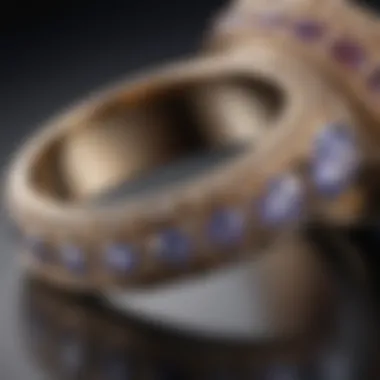
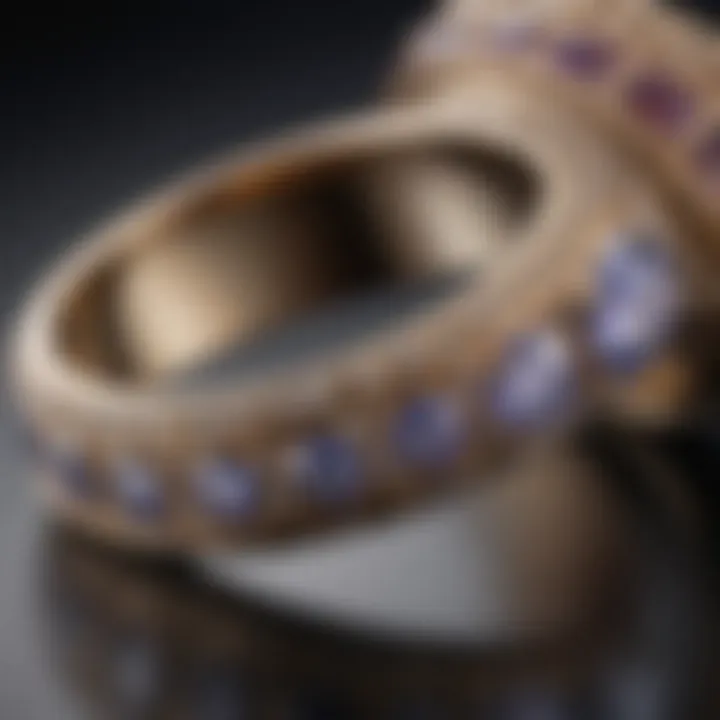
Crafted with a focus on symbolism, each ring often carries motifs resembling animals and natural elements found in the Nazca Lines. This connection to ancient art highlights the cultural relevance of the ring and its craftsmanship. Jewelry enthusiasts and collectors appreciate this piece for its historical background and artistry, making it a valuable addition to any collection. The narrative behind the design deepens its significance, bridging ancient culture with modern appreciation.
"Rings are not merely ornamental. They are repositories of history, significantly shaping personal and societal narratives throughout time." - Unknown
Rings of Power and Influence
Rings of Power and Influence hold a significant place in the narrative of history. They symbolize authority, legacy, and individuality across various cultures and eras. Their designs often reflect not only personal stories but also broader political or cultural contexts. In many instances, these rings have been more than mere adornments; they have marked pivotal moments in history. They serve as a testament to the power dynamics of their time, showing how those in control utilized such items to convey status and significance.
The concept of power embedded in rings can also be seen as a lens through which to understand societal structures. Different societies have infused their cultural values into ring designs, creating unique pathways to express influence. Thus, studying rings of power allows us to explore questions of identity, allegiance, and ambition.
The One Ring from 'The Lord of the Rings'
The One Ring from J.R.R. Tolkien's legendarium stands out as a core example of a ring with compelling power. Initially crafted by Sauron, it was imbued with a portion of his own essence, making it a conduit of great strength and control. This ring symbolizes not just personal power but signifies the inherent struggle between good and evil. Characters such as Frodo and Gollum reflect the different ways individuals can be influenced by power.
The One Ring represents corruption, desire, and the burden of power. Its ability to control minds and exert dominance over other beings shows how a simple piece of jewelry can alter fate. Many view this narrative as an allegory of power's ability to corrupt. This idea resonates with countless audiences, eliciting reflections on how power impacts human nature.
Napoleon's Signet Ring
Napoleon Bonaparte's signet ring carries its own fascinating story. His ring was not only a personal item but also a symbol of his authority as the Emperor of France. Typically used to seal important documents, such rings indicate status and power in a opulent manner. This particular ring featured intricate designs, potentially incorporating national symbols that highlighted his governance.
Napoleon understood the significance of his image and brand. By using a signet ring, he ensured that his power was visually represented in everyday affairs. Such rings cemented his identity as a leader and placed him in a historical context where symbols mattered greatly. Analyzing this ring provides insight into the relationship between personal representation and power.
In summary, both the One Ring and Napoleon's signet ring embody the multifaceted nature of power displayed through rings. They illustrate the interplay between personal ambitions and cultural narratives, marking their significance in the broader context of rings of power and influence. This discussion reveals how rings can encapsulate complex human experiences, making them vital subjects for study in history.
Cultural Relevancy of Rings
Rings hold a significant place in various cultures and societies, acting not only as adornments but also as vital symbols of status, love, and authority. Their roles transcend mere aesthetics, influencing personal and communal identities. This section will explore the various dimensions of rings in literature, art, and media, illustrating how these elements contribute to their cultural relevancy.
Rings in Literature
In literature, rings often symbolize intricate themes such as power, fidelity, and the complexity of human relationships. For example, J.R.R. Tolkien's The Lord of the Rings features the One Ring, a powerful object embodying corruption and desire. The narrative surrounding this ring reflects the eternal struggle between good and evil, impacting characters’ fates dramatically. Furthermore, in Shakespeare's Romeo and Juliet, Juliet’s ring signifies love and commitment, showcasing how jewelry can portray deep emotional connections.
The portrayal of rings in literature not only engages readers but also stimulates societal reflection. Literature allows for the exploration of social constructs surrounding marriage, loyalty, and even betrayal, often reflected in the rings worn by characters.
Rings in Art
Artistic representations of rings can be found throughout various cultures and eras, often illustrating their significance in rituals and traditions. Renaissance paintings frequently include rings as symbols of marriage or fidelity, seen in artworks like The Wedding at Cana by Paolo Veronese, where a ring signifies the bond between the couple.
Contemporary artists also employ rings in their work to explore themes of identity and materialism. The use of rings in mixed media pieces or sculptures can challenge traditional notions of value and significance. By placing rings in artistic contexts, artists provoke dialogue about societal norms concerning marriage, status, and love.
Film and Media Representations
Films and television shows have further cemented the relevance of rings in popular culture. Iconic rings often carry a significant narrative weight. For instance, the engagement ring in The Proposal highlights romantic tradition, while Harry Potter features the resurrection stone, which serves as a plot device brimming with emotional depth.
Moreover, reality shows like The Bachelor create dramatic moments centered around rings, making them symbols of popularity and desirability. These portrayals reflect society's fascination with rings as objects imbued with societal meanings, often influencing viewers' perceptions of romance and status.
"Rings serve as tangible connections to abstract concepts such as love and power, making them critical cultural artifacts."
Modern Interpretations of Historical Rings
The study of rings throughout history not only uncovers the significance of these adornments but also enlightens us about modern interpretations that pay homage to their legacy. In contemporary society, these modern designs serve as a bridge connecting the past with present aesthetics. They allow us to explore how historical symbolism and craftsmanship influence today’s jewelry design, shedding light on the intricate narratives such pieces convey.
Contemporary Designs Inspired by History
Throughout the decades, designers have continually drawn inspiration from historical rings. They often incorporate elements such as vintage styles, intricate detailing, and the use of materials reminiscent of earlier times. This blend enhances the emotional and cultural resonance of modern pieces.
Many modern rings feature aspects like:
- Classic Settings: Popular settings such as the halo or solitaire styles echo traditional designs yet are infused with modern flair.
- Material Innovation: While gold and silver remain favorites, the introduction of alternative materials like alternative metals or ethically sourced gemstones reflects modern values and preferences.
- Symbolic Elements: Modern pieces often integrate symbols that echo those found in historical rings, such as the infinity sign or meaningful inscriptions.
A carefully designed modern ring can transcend mere ornamentation, becoming a statement piece that conveys personal identity and cultural heritage. This exploration not only celebrates craftsmanship but also invites wearers into a traditional narrative that is continually evolving.
Popular Culture and Ring Trends
The resonance of rings in modern culture is significant. From literature to television, rings often symbolize ideals ranging from love to power. Notably, movies and series like 'The Lord of the Rings' have created renewed interest in rings, showcasing them as potent symbols in storytelling. This cultural infusion influences contemporary designs in various ways:
- Media Influence: Current pop culture often shapes fashion trends. Rings worn by celebrities or featured in films create significant demand, leading to the quick adoption of similar styles by mainstream consumers.
- Social Media Impact: Platforms like Instagram and Pinterest have made it easier for collectors and designers to showcase and discover unique ring designs that echo historical styles.
- Sustainable Practices: There’s a growing trend toward sustainable and ethically made jewelry. This shift includes reviving traditional craftsmanship to create pieces that are both eco-friendly and historically inspired.
Rings today embody a complex interplay of tradition and modernity. They not only serve as adornments but also as narrators of culture, identity, and history. As designers continue to innovate while respecting history, the modern interpretations of rings carve a vital niche in today’s jewelry landscape.
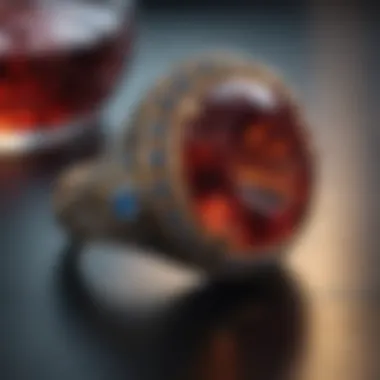
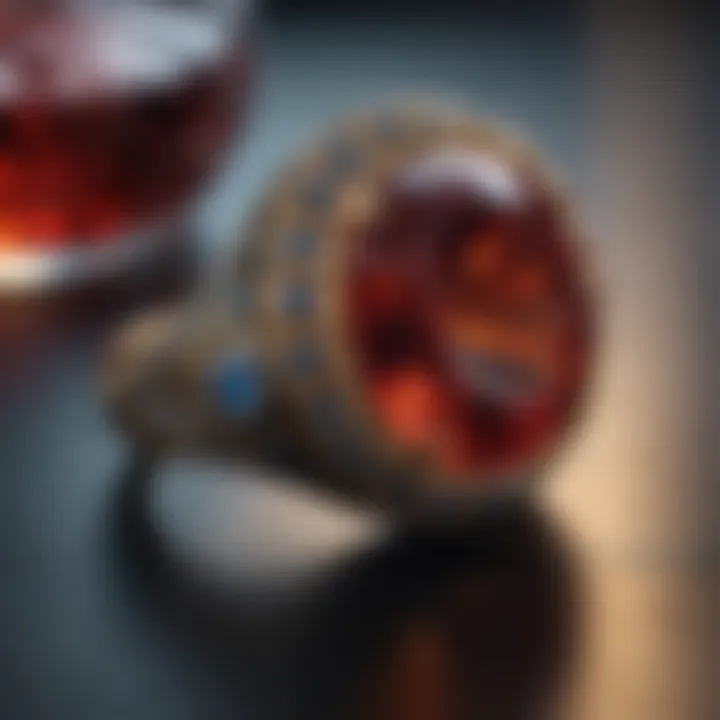
"Modern rings allow us to wear history, each piece a unique entry into the past that enhances contemporary life."
By acknowledging the past, we enrich our present and future, indicating that rings—historical or modern—will always have a place in our social fabric.
The Craftsmanship Behind Rings
The craftsmanship behind rings represents a fascinating intersection of artistry and functionality. Rings have been worn for centuries, serving various purposes, from symbols of love and commitment to declarations of power. This exploration of craftsmanship reveals the intricate processes and skilled hands that shape these iconic pieces. The significance lies not only in the physical attributes of the rings but also in the cultural narratives they convey.
Materials Used in Ring Making
The selection of materials is fundamental in ring making. Historically, artisans have chosen a variety of materials based on availability, symbolism, and aesthetic appeal.
- Precious Metals: Gold, silver, and platinum are commonly employed due to their durability and value. Each metal carries distinct meanings; for instance, gold symbolizes wealth and permanence, while silver is often associated with purity.
- Gemstones: Diamonds, rubies, sapphires, and emeralds are frequently used. Gemstones are not just valued for their beauty but also for their potential healing properties and spiritual significance. A diamond, for example, symbolizes eternal love, making it a standard choice for engagement rings.
- Alternative Materials: In modern times, materials like titanium, tungsten, and even wood have gained popularity. These materials often appeal to individuals seeking unique designs that reflect personal style and values.
"The craft of ring making is a delicate balance of tradition and innovation."
Techniques of Ring Craftsmanship
Crafting rings requires a deep understanding of various techniques that have evolved over time. Each method reflects the intended purpose of the ring and the wearer's identity.
- Casting: This technique involves pouring molten metal into a mold. It allows for intricate designs and is often used for creating custom pieces.
- Hand-Fabricating: In this method, artisans manually manipulate metal to achieve desired shapes. It is a labor-intensive process that results in unique craftsmanship.
- Engraving: This technique adds personalization to rings. Through engraving, artisans can etch names, dates, and symbols into the ring, often making it a cherished keepsake.
- Setting Stones: The skill of setting gemstones securely is crucial. Techniques like prong, bezel, and channel settings determine how a stone is showcased, enhancing the ring's overall appeal.
Historical Preservation of Rings
The significance of historical preservation extends beyond mere aesthetics; it embodies a cultural commitment to safeguarding artifacts that narrate human experience and creativity. Rings, as a unique form of personal adornment, offer insights into the societal values, skills, and artistry of their respective epochs. The preservation of rings allows both current and future generations to understand the intricate relationships between culture, power, and identity.
By placing emphasis on the preservation of these symbols, we ensure the continuity of knowledge surrounding different civilizations. Collections of historical rings in museums offer a tangible connection to the past. Visitors witness how materials, designs, and craftsmanship have evolved, thus fostering a deeper appreciation of human history.
Key considerations in the field of historical preservation include:
- Authenticity: Maintains the integrity of the artifact while avoiding alterations that could misrepresent its origin.
- Condition assessment: Involves careful analysis of the material conditions to determine the needs for restoration or conservation.
- Cultural contexts and sensitivities: Understanding the cultural significance behind each piece aids in the ethical preservation practices.
Ultimately, the preservation of rings serves as an invaluable testament to the cultures that produced them, making it essential to support and develop specialized preservation methods.
Museums and Historical Collections
Museums serve as guardians of history, curating collections that include rings of significant cultural, political, and artistic value. Institutions like the British Museum and the Metropolitan Museum of Art exhibit rings that span centuries, enabling visitors to explore different materials and craftsmanship techniques.
Rings in these collections are often tied to notable historical figures, thereby cementing their importance as symbols of power or devotion. The Ring of Solomon within the British Museum, for example, captures the imagination with its legendary provenance and intricate design. Such displays not only enrich public understanding but also underscore the responsibility that museums bear in conserving these artifacts for educational purposes.
- Educational Programs: Many museums offer workshops and lectures on jewelry design and conservation, fostering a new generation of enthusiasts and professionals.
- Online Catalogs: Digital archives allow for wider access to the collections, inviting global engagement with historical rings.
Conservation Techniques
Effective conservation techniques are vital for the longevity of historical rings. These techniques focus on both the aesthetic and structural integrity of the artifacts, ensuring that they continue to tell their stories without compromising their original form.
Some common methods include:
- Cleaning: Utilizes non-invasive options to remove dirt and residues without damaging the original surface.
- Environment Control: Maintaining consistent temperature and humidity levels in storage environments to prevent deterioration.
- Restoration Materials: Employing reversible materials to make repairs, ensuring that future conservators can undo any alterations made.
"Conservation is not about making the artifact 'perfect' but preserving its history and significance."
Such techniques require a skilled hand and a thoughtful approach, blending scientific knowledge with historical understanding.
In summary, through diligent historical preservation, societies can protect and interpret the rich narratives encapsulated in rings. Museums and innovative conservation approaches work collaboratively to maintain the integrity of these artifacts for posterity.
Culmination: The Lasting Legacy of Rings
The significance of rings extends far beyond their aesthetic appeal. Throughout history, they have served as symbols of power, love, and connection. The exploration of rings in this article highlights how these pieces of jewelry document human experience. From ancient signet rings to modern designs, each ring tells a unique story.
Future Trends in Ring Design
Modern ring design is continuously evolving. Some trends that might shape the future of this craft include:
- Sustainable Materials: With an increasing focus on eco-consciousness, jewelers are looking for sustainable options like lab-grown diamonds and recycled metals.
- Customization: Consumers often seek personalization to reflect individual values and styles, leading to greater demand for bespoke pieces.
- Technology Integration: Smart rings that monitor health or serve practical functions may gain popularity, merging technology with classic design.
"Rings are not just ornaments; they embody messages of identity and emotion."
These trends indicate a departure from traditional craftsmanship toward innovative creations that appeal to the tech-savvy consumer while maintaining the essence of artistry.
Continued Cultural Significance
Rings retain their cultural relevance across various arenas. They appear in literature, representing loyalty and commitment, as seen in Shakespeare’s works. In art, rings symbolize status and wealth, often depicted in portraits of nobility. Furthermore, rings are prominent in films and media, capturing viewers’ imaginations through iconic representations.
The ongoing significance of rings suggests they will remain integral to human culture. Their meanings may shift, but the act of wearing a ring will continue to evoke tradition, belief, and identity. As we explore the future of these symbols, it is essential to recognize their enduring legacy within society.



